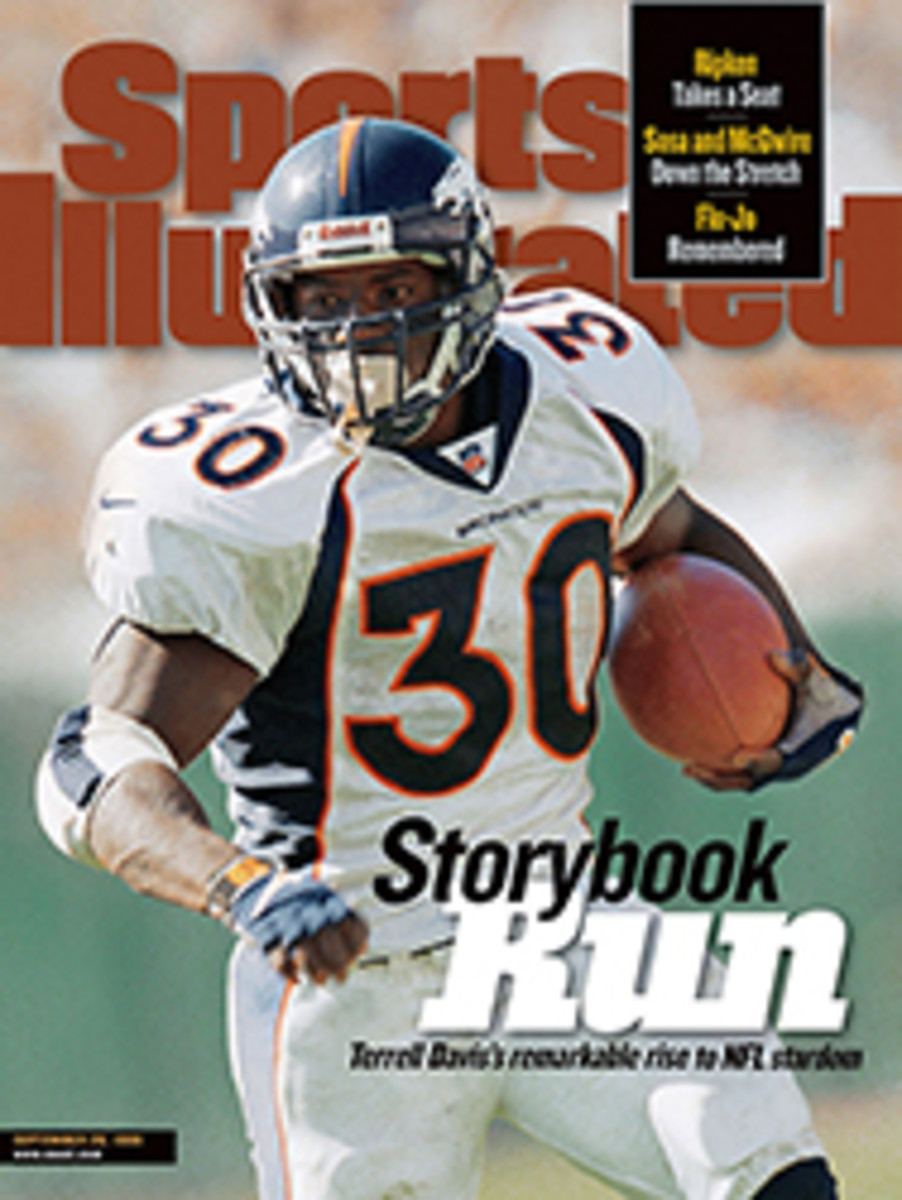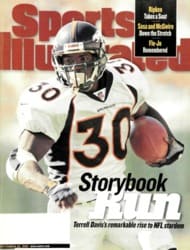
Inside Motor Sports
'I MISS HIM BAD'
In his best season, Mark Martin is haunted by the mystery of his
dad's death
Things couldn't be better for Mark Martin on the racetrack. On
Sunday he dominated the MBNA 400 at Dover, Del., leading 380 of
the 400 laps to give him a career-best six wins this season. Off
the track, however, he continues to grieve over the death of his
father, Julian, who was 62, in an Aug. 8 plane crash. In fact,
the unknown circumstances of the accident, which also took the
lives of Julian's wife, Shelley, 38, and their 11-year-old
daughter, Sarah, still keep Mark awake.
Julian was flying his twin-engine Piper Cheyenne home to Searcy,
Ark., after visiting relatives in Santa Rosa, Calif., when the
plane crashed near Great Basin National Park in Nevada. The
National Transportation Safety Board is conducting an
investigation, the results of which may not be available for
months.
"I'm a pilot," says Martin, who owns a 1995 Cessna Citation jet
and flies it back and forth from the hangar adjacent to his
house in Daytona to Winston Cup races. "So it's not just O.K.
for me to say, 'Well, something happened to their airplane, and
they crashed.' My father was a tremendous pilot. He could do
anything and was afraid of nothing. I want to know what killed
my hero."
Last week Martin received a copy of the cockpit voice tape and
had listened to the final minutes 50 times by Saturday. "I've
heard his last words," Martin says. "He called and said he'd
lost cabin pressure [at about 27,000 feet] and needed immediate
descent. The air-traffic controllers didn't hear him and called
back, asking, 'What did you say?' and he said, 'I need immediate
descent.'"
There has been speculation that Julian and the others lost
consciousness before descending to a safe altitude. Martin
doesn't believe this theory. "His voice sounds urgent," he says,
"but at no point does he seem as if he's suffering from effects
of lack of oxygen."
Mark was only five when Julian took him out on backcountry
gravel roads in their hometown of Batesville, Ark., and taught
him to drive. The son sat in the father's lap behind the wheel
while Julian floored the accelerator, forcing a sometimes
sobbing Mark to steer the car to avoid crashing. Julian drank to
excess, often drove recklessly and had a rocky relationship with
Mark's mother, Jackie, whom he divorced, remarried and divorced
again. In recent years Julian had quit drinking and was devoted
to his second family.
"He didn't always do the right things, but I don't hold any
strikes against him," says Mark. "When he did good things, he was
good." Julian had an intensity and a work ethic that he passed on
to his son. While managing his own thriving trucking business,
Julian moonlighted as his son's car owner and chief mechanic
during Mark's early racing days.
While Martin waits for the investigation to conclude, he relishes
the distraction that racing provides. "I'm doing the best I can,
but I miss him bad," he says. "There won't be closure on this
until I know what happened."
CART-IRL Negotiations
INDY 500 BOYCOTT MAY END
Discussions between CART president Andrew Craig and a top
lieutenant of Indianapolis Motor Speedway president Tony
George's could lead to the return of CART teams to the
Indianapolis 500 as early as 2000.
The negotiations center on a compromise proposed by CART's
engine suppliers--Ford, Honda, Mercedes-Benz and Toyota. CART
uses turbocharged 2.65-liter engines, and George's Indy Racing
League (IRL) runs so-called production-based normally aspirated
four-liter power plants. The CART suppliers are offering a
hybrid: a normally aspirated three-liter engine that would
nevertheless be a thoroughbred for racing.
The toughest obstacle may be hammering out an agreement on
whether teams would be allowed to own engines, as they are in
the IRL, or be required to lease them, as they are in CART. "The
one major issue between us is who controls the engines--the
manufacturer or the team," says CART owner-driver Bobby Rahal.
"Once that is sorted out, everything else is a piece of cake."
Sorting it out will be no easy matter, if only because of the
intransigence of powerful IRL team owner A.J. Foyt. To keep
technology secrets from falling into the hands of other
manufacturers, CART's engine makers stipulate in their leasing
agreements that teams' engines must be tuned and maintained by
engineers provided by the manufacturers. Foyt insists on
retaining the right to own engines and work on them as he
pleases. "The only thing I don't like about CART's system is its
lease program," he says. "That's not racing. That's a lot of
money for nothing."
Providing Foyt can be talked off his high horse--which is far
from a given--there are strong reasons for George and the IRL to
make a deal, which could not be implemented until 2000 because
of the time needed to perfect new engines. George has seen the
prestige of the Indy 500 wane since CART pulled out in 1996 over
George's formation of the IRL and his decision to reserve 25 of
the 33 Indy 500 starting berths for IRL drivers. (George has
since lifted that rule.) The IRL has only one major engine
supplier, Oldsmobile, and prospects are bleak for suppliers
after 1999, when Oldsmobile's contract expires. One track, New
Hampshire International Speedway, has already dropped the IRL
because of low attendance, and three others--Atlanta, Charlotte
and Phoenix--find IRL races increasingly difficult to promote.
Zanardi Changing Cars
CART'S LOSS IS F/1'S GAIN
CART's whirlwind driving phenomenon, known to U.S. fans as Alex
Zanardi, soon will be no more. Alessandro Zanardi will return to
Formula One next season, leaving behind the Americanized
diminutive he hated and the pizzazz he pumped into the series
while winning two consecutive championships.
The Williams team of England was expected to announce this week
that Zanardi, 31, will pair up in 1999 with Ralf Schumacher, 23,
younger brother of two-time F/1 world champion Michael
Schumacher, behind the wheel of the Williams-Mecachrome cars.
Zanardi, who has been absent from F/1 since 1994, is committed to
going back because of F/1's greater prestige and because his
wife, Daniela, wants them to raise their month-old son, Niccolo,
in their native Italy.
For the latest news from all the motor sports circuits, plus
more from Ed Hinton, go to www.cnnsi.com.
COLOR PHOTO: NIGEL KINRADE A six-pack Martin's win at Dover on Sunday gave him half a dozen victories in 1998. [Mark Martin uncorking champagne bottle beside MBNA 400 trophy]
COLOR PHOTO: ROBERT LABERGE/ALLSPORT Rarin' to go After back-to-back CART championships, Zanardi is steering his career back to Formula One. [Pit stop crew working on car driven by Alex Zanardi]
IN THE DRIVER'S SEAT
Martinsville speedway, site of this Sunday's NAPA 500, is the
smallest oval on the Winston Cup tour, only .526 of a mile.
Bobby Hamilton, a short-track specialist who won the Goody's 500
there in April, explains the tricks of winning on a bullring.
You brake from 140 mph on the straightaways down to 60 in the
turns. To win, you must avoid burning up your brakes. One way is
to bank off other cars--drive inside them and literally bounce
off them--through the turns. Although such low speeds feel fast
because the track is so short, you try things you wouldn't dare
do on superspeedways. When somebody blocks me, I might drive
right over a curb to pass him.

